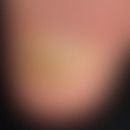HistoryThis section has been translated automatically.
The French dermatologist Louis Jean Brocq is credited with the first description of this entity as "parakeratosis psoriasisformis" in 1921. However, the first case was described by Sabouraud in 1931. The term "parakeratosis pustulosa" was coined by Niels Hjorth and Thomsen in 1967.
DefinitionThis section has been translated automatically.
Clinical picture with doubtful entity for acral localized pustular dermatitis with subungual hyperkeratosis, nail dystrophies and onycholysis.
Tosti et al. reported on long-term follow-up of 20 pediatric patients with parakeratosis pustulosa. In eight children, PKP was considered a clinical manifestation of psoriasis. In four patients, parakeratosis pustulosa was considered a symptom of allergic contact dermatitis, while in two patients atopic dermatitis was possibly responsible for PKP. A complete cure of the disease was observed in 11 patients.
The results of this study suggest that PKP is not a singular entity, but rather a clinical "nail symptom" that can be caused by various inflammatory conditions, including nail psoriasis, atopic dermatitis and contact dermatitis.
You might also be interested in
EtiopathogenesisThis section has been translated automatically.
The etiology of PP remains unclear. A connection with pustular psoriasis (acrodermatitis continua suppurativa type), atopic dermatitis and contact dermatitis is suspected. However, "thumb sucking" may also play an etiologic role.
ManifestationThis section has been translated automatically.
Exclusively children ≤5 years
LocalizationThis section has been translated automatically.
Fingers, most commonly the tips of the thumb and middle finger are affected. Involvement of the toes is rare.
ClinicThis section has been translated automatically.
Vesiculopustules are found in the area of the hyponychium, with pink eczematous, scaly plaques. The lesions can also spread to the nail folds or the dorsal side of the fingers. There is distal onycholysis. The nail plate itself may show ridging, while other nail changes such as thickening or pitting are rare. Patients are usually asymptomatic.
HistologyThis section has been translated automatically.
The histologic features of PP are nonspecific and resemble psoriasis or chronic eczema. They include parakeratosis, hyperkeratosis, acanthosis, intraepidermal pustules, papillomatosis, mild exocytosis and dilated blood vessels in the papillary dermis with perivascular lymphohistiocytic and/or polymorphonuclear infiltrate.
Differential diagnosisThis section has been translated automatically.
The differential diagnosis of PP includes both non-infectious (acrodermatitis continua of Hallopeau, pustular (e.g. nail psoriasis) and infectious (blistering distal dactylitis) dermatoses.
Note(s)This section has been translated automatically.
Since this disease name has not appeared in the literature in the last 10 years and the clinical findings are only vaguely defined, this daignosis can be dispensed with.
LiteratureThis section has been translated automatically.
- Brocq L (1921) In: Doyn G, editor. Precis - atlas de dermatologic Paris p 909.
- Cronin E et al (1986) Parakeratosis pustulosa. Clin Exp Dermatol 11:643-645.
- Gaurav V et al. (2022) A Case of Pustules on the Fingertip in a Child. Skin Appendage Disord 8: 435-440.
- Hjorth N et al (1967) Parakeratosis pustulosa. Br J Dermatol 79:527-532.
- Pandhi D et al. (2003) Parakeratosis pustulosa--a distinct but less familiar disease. Indian J Dermatol Venereol Leprol 69:48-50.
- Sabouraud R (1931) Les parakeratoses microbiennes du bout des doigts. Ann Derm 11:206-210.
- Tosti A et al. (1998) Clinical features and long-term follow-up of 20 cases of parakeratosis pustulosa. Pediatr Dermatol 15:259-263.
Disclaimer
Please ask your physician for a reliable diagnosis. This website is only meant as a reference.







